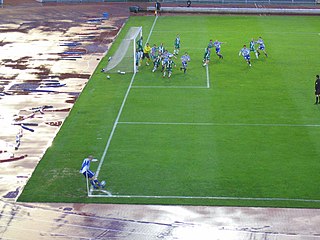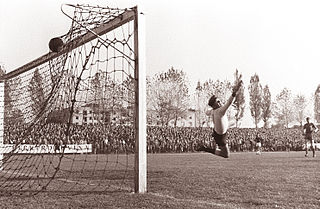
Association football, more commonly known as simply football or soccer, is a team sport played with a spherical ball between two teams of 11 players. It is played by approximately 250 million players in over 200 countries and dependencies, making it the world's most popular sport. The game is played on a rectangular field called a pitch with a goal at each end. The object of the game is to outscore the opposition by moving the ball beyond the goal line into the opposing goal. The team with the higher number of goals wins the game.

Gaelic football, commonly referred to as football or Gaelic, is an Irish team sport. It is played between two teams of 15 players on a rectangular grass pitch. The objective of the sport is to score by kicking or punching the ball into the other team's goals or between two upright posts above the goals and over a crossbar 2.5 metres (8.2 ft) above the ground.

Offside is one of the laws of association football, codified in Law 11 of the Laws of the Game. The law states that a player is in an offside position if any of their body parts, except the hands and arms, are in the opponents' half of the pitch, and closer to the opponents' goal line than both the ball and the second-last opponent.
Card or The Card may refer to:

In sport, a goal may refer to either an instance of scoring, or to the physical structure or area where an attacking team must send the ball or puck in order to score points. The structure of a goal varies from sport to sport, and one is placed at or near each end of the playing field for each team to defend. For many sports, each goal structure usually consists of two vertical posts, called goal posts, supporting a horizontal crossbar. A goal line marked on the playing surface between the goal posts demarcates the goal area. Thus, the objective is to send the ball or puck between the goal posts, under or over the crossbar, and across the goal line. Other sports may have other types of structures or areas where the ball or puck must pass through, such as the basketball hoop.

A penalty kick is a method of restarting play in association football, in which a player is allowed to take a single shot on the goal while it is defended only by the opposing team's goalkeeper. It is awarded when a foul punishable by a direct free kick is committed by a player in their own penalty area. The shot is taken from the penalty mark, which is 11 m from the goal line and centred between the touch lines.
The Laws of the Game (LOTG) are the codified rules of association football. The laws mention the number of players a team should have, the game length, the size of the field and ball, the type and nature of fouls that referees may penalise, the frequently misinterpreted offside law, and many other laws that define the sport. During a match, it is the task of the referee to interpret and enforce the Laws of the Game.

A corner kick is the method of restarting play in a game of association football when the ball goes out of play over the goal line, without a goal being scored and having last been touched by a member of the defending team. The kick is taken from the corner of the field of play nearest to where it went out. Corners are considered to be a reasonable goal scoring opportunity for the attacking side, though not as much as a penalty kick or a direct free kick near the edge of the penalty area.

A goal kick, called a goalie kick in some regions, is a method of restarting play in a game of association football. Its procedure is dictated by Law 16 of the Laws of the Game.
Kickoff or kick-off may refer to

The Sheffield Rules was a code of football devised and played in the English city of Sheffield between 1858 and 1877. The rules were initially created and revised by Sheffield Football Club, with responsibility for the laws passing to the Sheffield Football Association upon that body's creation in 1867. The rules spread beyond the city boundaries to other clubs and associations in the north and midlands of England, making them one of the most popular forms of football during the 1860s and 1870s.

The Cambridge Rules were several formulations of the rules of football made at the University of Cambridge during the nineteenth century. One of these codes, dating from 1863, had a significant influence on the creation of the original Laws of the Game of the Football Association.

The goalkeeper, often shortened to keeper or goalie, is one of the major positions of association football. It is the most specialised position in the sport. The goalkeeper's primary role is to prevent the opposing team from scoring. This is accomplished by the goalkeeper moving into the path of the ball and either catching it or directing it away from the vicinity of the goal line. Within the penalty area goalkeepers are able to use their hands, making them the only players on the field permitted to handle the ball. The special status of goalkeepers is indicated by them wearing different coloured kits from their teammates.
The term or acronym GARP can refer to:
Swedish football was a code of football devised and played in Sweden from the 1870s to the early 1890s, when the modern association football was introduced. Swedish football rules were a mix of the association football rules and the rugby football rules, most closely resembling the former.
High school football is gridiron football played by high school teams in the United States and Canada. It ranks among the most popular interscholastic sports in both countries, but its popularity is declining. According to the Washington Post, between 2009 and 2019, participation in high school football has declined by 9%.
A stone is a small piece of rock.

In games of association football teams compete to score the most goals during the match. A goal is scored when the ball passes completely over a goal line at either end of the field of play between two centrally positioned upright goal posts 24 feet (7.32 m) apart and underneath a horizontal crossbar at a height of 8 feet (2.44 m) — this frame is itself referred to as a goal. Each team aims to score at one end of the pitch, while preventing their opponents from scoring at the other. Nets are usually attached to the goal frame to catch goalscoring balls, but the ball is not required to touch the net.

A free kick is a method of restarting play in association football. It is awarded after an infringement of the laws by the opposing team.
This page is based on this
Wikipedia article Text is available under the
CC BY-SA 4.0 license; additional terms may apply.
Images, videos and audio are available under their respective licenses.











